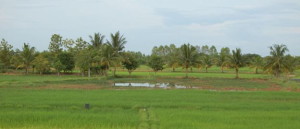Rice agro-ecosystems are man-made wetlands that support considerable aquatic biodiversity and often, productive fisheries. Southeast Asian rice farmers often manage aquatic habitats and resources on their land to increase production of wild aquatic organisms. We have worked with the Institute of Aquaculture, Asian Institute of Technology, the Fisheries Departments of Cambodia and Thailand and RIA1 Vietnam to characterize such ‘farmer-managed aquatic systems’ (FMAS) and to evaluate their role in conserving and enhancing fisheries resources.
We characterized ‘farmer-managed aquatic systems’ (FMAS) in six regions of Cambodia, Thailand and Vietnam on the basis of their physical attributes, management practices, and fisheries production and utilisation. More than 80% of rice farming households in Thailand and Cambodia harvest aquatic animals from their land, and over 70% create aquatic habitats such as ponds in order to increase aquatic resource production. Cambodian households tend to create and utilize a wide variety of man-made aquatic habitats on their land, while Thai households use predominantly trap ponds. The majority of households in Cambodia and Thailand harvest wild fish from both FMAS and from open waters, with FMAS accounting for over half of total catches. In both countries, wild aquatic animals account for over 90% of the catch, with the remainder being stocked hatchery fish. By contrast, less than half of Vietnamese farming households harvest wild aquatic animals from their land, and very few undertake habitat management specifically for such animals. Vietnamese FMAS were intensively stocked and managed as aquaculture systems, with wild fish accounting for less than 30% of production. The differences in FMAS characteristics between regions are related to topography, water resource availability, farming practices, and abundance of wild aquatic species. FMAS are found primarily in lower-intensity rice farming systems and contribute substantially to food production and wider ecosystem services from these systems.
A high diversity of wild aquatic organisms was identified in Cambodian and Thai FMAS. The wild fish catches in FMAS were obtained with much lower fishing effort than those from open systems, indicating a positive effect of FMAS management on fisheries productivity. A large share of this positive effect is attributable to lower harvesting effort in FMAS where access is restricted to the owner’s household as compared to open systems. Of the other indigenous management measures, the construction of brush parks and manuring were associated with positive effects on productivity in Cambodia and Thailand. FMAS support substantial aquatic biodiversity in traditional rice farming landscapes, and yield significant benefits to farmers in terms of aquatic resource availability and productivity. Our work on aquatic resource management on rice farms has been supported by the UK Department for International Development.
Arthur, R.I., Lorenzen, K., Homekingkeo, P., Sidavong, K., Sanvilaikham, B. & Garaway, C.J. (2010) Assessing impacts of introduced aquaculture species on native fish communities: Nile tilapia and major carps in SE Asian freshwaters. Aquaculture 299: 81-88. PDF
Amilhat, E., Lorenzen, K., Morales, E.J., Yakupitiyage, A. & Little, D.C. (2009) Fisheries production in Southeast Asian farmer managed aquatic systems (FMAS): II. Diversity of aquatic resources and management impacts on catch rates. Aquaculture 298: 57-63. PDF
Amilhat, E., Lorenzen, K., Morales, E.J., Yakupitiyage, A. & Little, D.C. (2009) Fisheries production in Southeast Asian farmer managed aquatic systems (FMAS): I. Characterisation of systems. Aquaculture 296: 219-226. PDF
Morales, E.J., Little, D.C., Immink, A., Demaine, H., Yakupitayage, A., Amilhat, E. & Lorenzen, K. (2006) Contribution of self-recruiting species produced in farmer-managed aquatic systems in rural areas of Southeast Asia to food consumption.. Journal of Food Composition and Analysis 19: 759-760. PDF
Amilhat, E. & Lorenzen, K. (2005) Habitat use, migration pattern and population dynamics of chevron snakehead Channa striata in a rainfed rice farming landscape. Journal of Fish Biology 67(SB):23-34. PDF
Amilhat, E., Morales, E.J., Immink, A., Little, D.C., Lorenzen, K., Ul Islam, F. & Karapanagiotidis, I. (2005) Self-recruiting species in aquaculture: their role in rural livelihoods. Summary Report. DFID Aquaculture and Fish Genetics Research Programme. PDF

